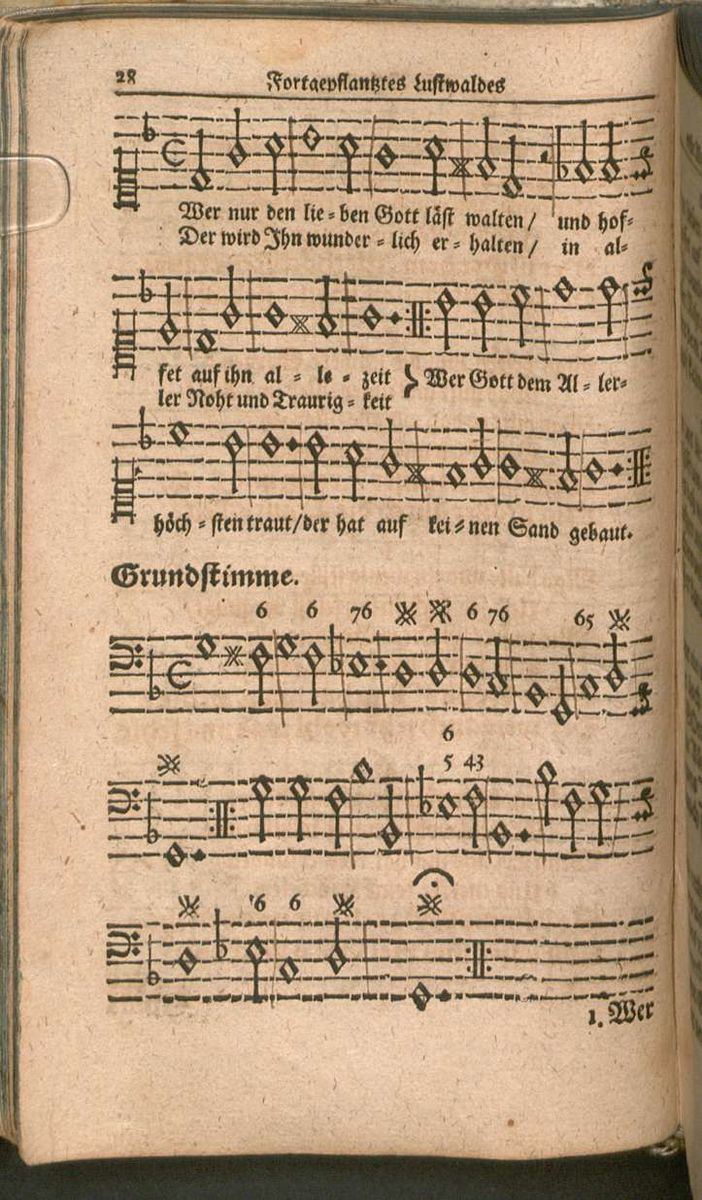 | ||
"Wer nur den lieben Gott läßt walten" (He who allows dear God to rule him) is a 1641 hymn by Georg Neumark, who also composed the melody for it. It has seven verses and deals with the Christian putting their trust in God. Its author referred to it as a "Trostlied" or song of consolation and it first appeared in his Fortgepflantzer musikalisch-poetischer Lustwald (published in Jena in 1657). It also appeared in Johann Crüger's 1672 Praxis pietatis melica and in the first part of Johann Anastasius Freylinghausen's 1704 Geistreiches Gesangbuch.
Contents
Melody
Twenty other melodies have since been written for the text, though none have reached the same popularity as the original. The original melody has been used for several other hymns and become one of the main melodies in Protestant hymnody. In a widespread print version with two ♭ - signs, it is in the key of G minor - Neumark's original version only has one ♭.
Melody in 3/2 time by Georg Neumark 1657
Version of melody in 4/4 time used by J. S. Bach
Text
Below is Neumark's original German text with the English translation of Catherine Winkworth.
Neumark's 1657 hymnbook
In his 1657 hymnbook, Fortgepflantzter musikalisch-poetischer Lustwald, Neumark devoted 5 pages to the text, melody and accompaniment of the hymn "Wer nur den lieben Gott läßt walten".
Bach
Johann Sebastian Bach repeatedly used the hymn tune in his compositions, most notably in BWV 93, his cantata of the same name, for the fifth Sunday after Trinity, composed for 9 July 1724. Its text is based on Neumark's original, which is retained verbatim in the first and last verses and rewritten elsewhere. The same melody was set to different words in other hymns, notably Wer weiss, wie nahe mir mein Ende ("Who knows how near is my end?"). Cantatas BWV 21, BWV 27, BWV 84, BWV 88, BWV 166, BWV 179 and BWV 197 use the original melody, with words taken from one or other of the texts. Cantata 21 links two stanzas with a three-part fugue (Sei nun wieder zufrieden, meine Seele); the tenor and soprano sing the cantus firmus.
BWV 642 in the Orgelbüchlein is a chorale prelude for organ, with the hymn tune as its cantus firmus; whilst BWV 647 in the Schübler Chorales is an organ transcription of the fourth movement of the cantata BWV 93. In addition, two organ adaptations of the hymn are included in the Kirnberger Collection - BWV 690 (with a following figured basso-chorale) and BWV 691 (with an interesting variant and additional interludes). Another variant, the chorale prelude BWV 691a, can be found in the Klavierbüchlein für Wilhelm Friedemann Bach.
Other composers
Felix Mendelssohn also adapted the text and melody as a cantata. Johannes Brahms also used it as a theme at various points in his German Requiem. Ralf Grössler included a meditation on the hymn's original melody in his 1988 Missa Dei Parvulorum. Max Reger composed a two chorale preludes as Nos.45 and 46 of his 52 Chorale Preludes, Op. 67 in 1902. In 2002 a new three-part a capella setting of the hymn was produced for the German movie Vaya con Dios.
Current liturgical usage
The hymn is No. 369 (EC 369) in the Evangelisches Gesangbuch and number 367 in the hymnbook of the Evangelisch-methodistische Kirche in Germany, though in the latter verse 5 is omitted. In the present Catholic hymnal Gotteslob, stanzas 1–3, 6 and 7 appear as hymn number 424. Stanzas 1, 2 and 7 are number 451 in the Swiss Katholisches Gesangbuch der deutschsprachigen Schweiz, the same selection was number 295 in the first edition of the Gotteslob. In the German hymnbook of the Neuapostolische Kirche, stanzas 1–5 and 7 appear as number 154.
